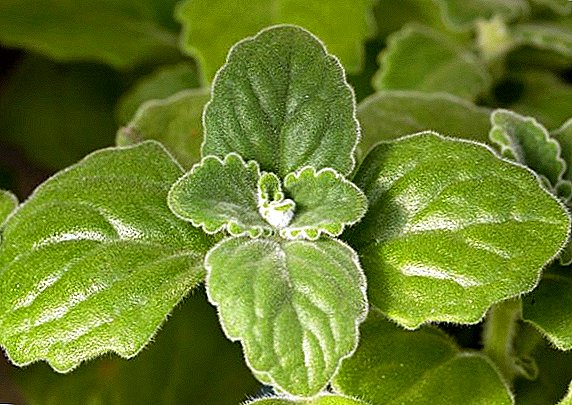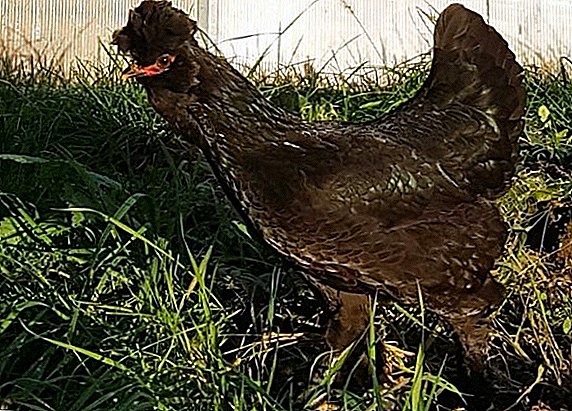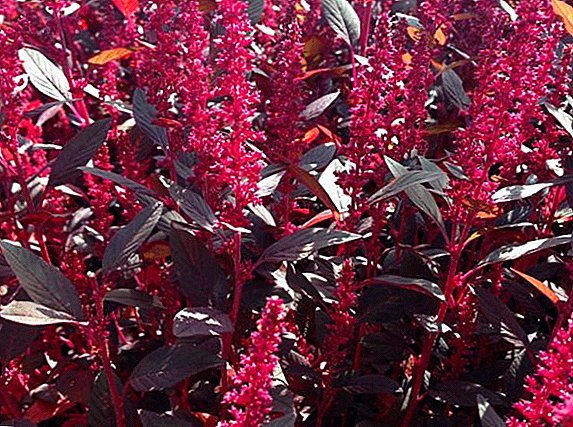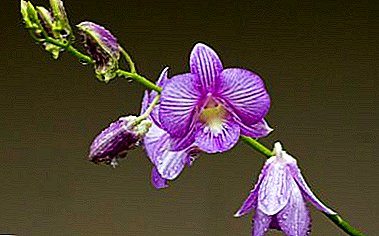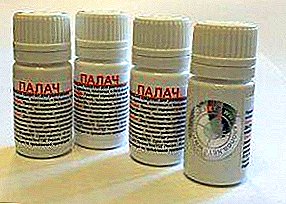
Geranium, due to its decoration and unpretentiousness in the care, gained popularity in our country for a long time.
For many, this plant is associated with the house of a grandmother or mother, almost everyone remembers its appearance and the smell of leaves from childhood.
Tulip geranium today remains exotic, but unusual flowers, which are collected in miniature bouquets, inflorescences, rich flowering throughout the year attracts increasing attention of amateur flower growers. In the article you will read more about this plant, see how its flowers look like tulips in the photo.
Description and history of appearance
Geranium tulip belongs to the family of geranium, its main difference from the usual geranium in miniature, not more than a centimeter, colors resembling unopened tulips, gathered into inflorescences, in which there can be 30-50 flowers.
Unusual flowers and abundant flowering that can last the whole year are the main properties for which this variety is valued.
The color of different varieties of tulip geraniums varies from pink to maroon, the inner part of the corolla is more often colored more brightly than the outer one.
A similar type of geranium was bred in the private nursery of the Andrea family in the USA, in Boston in 1966 and was named Patricia Andrea. But among breeders there is a debate about the origin, many believe that geranium with unusual colors was the result of an accidental mutation of varieties with ordinary colors.
The breeders of the Andrea family managed to breed several more varieties, which according to tradition received the names of women belonging to the family Andrea. Selection of varieties is difficult due to the special structure of the petalsthat make it difficult to access pistils and stamens.
Description of appearance and popular varieties
There are not many species, all of them are united by an unusual form of a flower, the petals of which are closed like a tulip bud. Inflorescences look like a miniature bouquet of 30-50 tulips. The color of tulip geraniums is diverse, it can be both gently pink and burgundy, there are both tall plants, up to 80 cm, and dwarf, petals can be smooth and with terry edges.
Today there are fourteen varieties of tulip geraniums.. The complexity of the hybridization of this species in the features of the flower structure. Varieties differ in shape and color of flowers, number of petals, size of plant, shape and color of leaves.
The most famous varieties to date and their photos
Helma
Dwarf variety with large inflorescences, which collected up to forty orange flowers.

Conny
A miniature plant in height and width with oblong flowers of bright red color and emerald velvety carved flowers.

Emma fran bengstbo
Grows up to 80 cm, possesses elongated flowers of pinkish-white color with gently green elongated leaves, slightly curling upwards.

Patricia Andrea
Medium plant, flowers of red-pink color, foliage brilliant, dark emerald with carved edges.

Red pandora
Geranium with bright pink flowers with red veins, gathered in lush inflorescences, leaves of emerald color velvety.

Landing and home care rules
Generally geranium tulip, as well as her relatives, unpretentious, but if the conditions of detention are not observed, it may lose its peculiarity; its flowers will take the form of ordinary geranium, in particular, an excess of ultraviolet radiation may serve it.
Lighting
The lack of light can lead to the fact that the plant stems stretch, the leaves turn pale, the flowering time is shortened, and the buds may not form at all.
Temperature
Geranium is sensitive to sudden temperature changes.optimal for her in the summer of 21 - 26about C degrees, in winter 14 - 16about. It is also necessary to protect the plant from drafts and hot air coming from the heaters.
The soil
When choosing a soil, it is necessary to pay attention, first of all, to drainage, which should prevent the roots from rotting, which may be sand or turf. You can use the prepared mixture or cook yourself. Two mixtures are available for growing tulip geraniums:
- Mix 2 parts of garden soil with 2 parts of peat and add 1 part of sand.
- 2 parts of peat plus 2 parts of humus, add 2 parts of sod and mix with 1 part of sand.
It is best to plant in a clay pot with a diameter of 12-14 cm and a height of 10-15 cm.
Watering
In the summer, you should water the geranium four times a week., and in winter it is enough once. In case of an excess of moisture, improperly selected soil, root rot may occur, then the plant will die before the owners detect the problem.
Top dressing
In the autumn-winter period, it is necessary to feed one to two times a month with liquid fertilizers, which include phosphorus and potassium. It is worth noting that an overabundance of fertilizers, especially nitrogen, can lead to the fact that the green part of the plant grows to the detriment of rich flowering.
Care features
 To preserve the decorative properties of tulip-shaped geraniums, to preserve the shape of an unopened tulip, it is advised to pinch the tops of the plants in order to give bushiness, to remove dried flowers, to create new ones in their place, to avoid drafts and strong wind, if pelargonium is on the street.
To preserve the decorative properties of tulip-shaped geraniums, to preserve the shape of an unopened tulip, it is advised to pinch the tops of the plants in order to give bushiness, to remove dried flowers, to create new ones in their place, to avoid drafts and strong wind, if pelargonium is on the street.
If the flowers are open, they must be removed.If this happens again, then the geranium should be cut out at the root and from the new shoots try to grow a plant with tulip flowers.
Major Diseases and Pests
If white circles, gray patina or red castings on the leaves and stems are detected on the leaves, it is necessary to take urgent measures. Like other geranium species, whitefly is dangerous; mealy worm; spider mite; rust; gray rot Consider the main symptoms and methods of treatment of plants.
- The defeat of the geranium by the whitefly manifests itself in the form of yellowing and dropping of leaves; as a treatment, the plant is treated with insecticides.
- With the appearance of cobwebs and small insects, white and yellow dots, drying of the leaves, you can most likely talk about the defeat of the plant with a spider mite, in the fight against which you use alcohol to wipe the leaves.
- White bloom, reminiscent of cotton wool, sugary discharge indicate a mealy worm on geranium, which is destroyed with a cotton pad moistened in soapy water.
- White geranium circles are rust, which can be fought by removing the affected leaves and using fungicides, substances to combat fungal diseases on plants.
- When a gray plaque appears, it is possible to talk about the defeat of a plant with gray rot, in which case the affected leaves should be removed.
- If the stems turn black, the leaves curl and fall off, then the plant affected by the black stem should be removed so that the disease does not spread to healthy flowers.
Breeding
The preferred breeding method is reproduction using cuttings.
In the spring or at the end of August, right after flowering, the apical shoots are cut, which are either placed in water or in a mixture of sand and peat. After the cuttings have given their roots are transplanted into fertile soil the same as for an adult plant.
Harder to grow geraniums from seed. There is a danger that the resulting plant will not have its own unique features, besides it is quite difficult to buy high-quality seeds of this geranium. However, if you decide to grow geranium from seeds, you should follow the following algorithm.
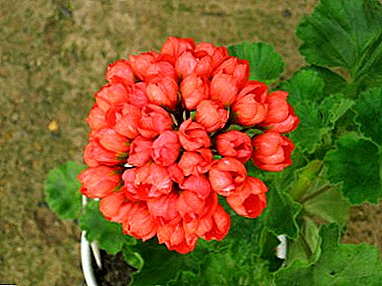 Before planting, the seeds should be slightly rubbed with sandpaper or put a knife edge on them for better germination.
Before planting, the seeds should be slightly rubbed with sandpaper or put a knife edge on them for better germination.- Soak the seeds in a growth stimulator, then in a solution of potassium permanganate and finally in ordinary water for three hours.
- The soil for planting seeds should consist of sod (two parts), peat (two parts) and sand (one part).
- Planting seeds should be at a distance of five centimeters from each other, the seeds should not be deepened much
- The container, in which the seeds are planted, should be wrapped with cling film to create a greenhouse effect until the seedlings that appear after about two weeks, you must ensure that the soil does not dry out.
- When two leaves appear on the geranium seedlings, the plant can be transplanted into a pot.
Despite some peculiarities in the care, tulip-like geranium is rightly winning new fans among gardeners. The unobtrusive tender beauty of this variety provides it with a worthy place among the ornamental plants in apartments, houses, balconies and private plots.


 Before planting, the seeds should be slightly rubbed with sandpaper or put a knife edge on them for better germination.
Before planting, the seeds should be slightly rubbed with sandpaper or put a knife edge on them for better germination.

